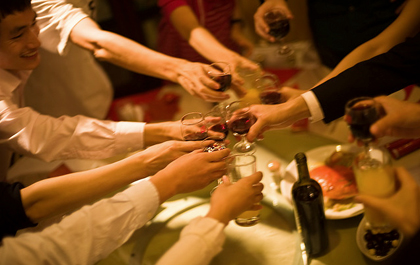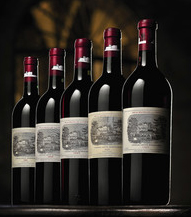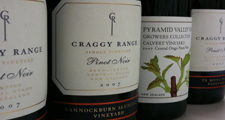Dr Vino's wine blog
wine talk that goes down easy
Auction booty, 50 Cent, adulteration, heir apparent – sipped & spit

SIPPED: boom times
Wine auctions brought in a total of $408 million, nearly doubling the 2009 take according to Peter Meltzer. Hong Kong boomed, with $165 millon in wine auctions, surpassing New York’s $154 million. According to the article, the five largest auction houses by wine gross are: Acker worldwide, Sotheby’s worldwide, Christie’s worldwide, Zachys worldwide, and Hart Davis Hart Chicago. The highest price paid for one 750ml bottle was $232,692 for 1869 Lafite. Bottoms up!
SIPPED: chemicals
Chinese Central Television, an outfit not known for investigative journalism, has outed 30 wineries practicing wine adulteration in Changli County of Habei Province, leading to their closure. [ShanghaiDaily.com]
SIPPED: the stuff of sitcoms
Not all the “hot” wine was mulled over the holidays: two thieves broke into rapper 50 Cent’s Connecticut mansion; one was found in the closet drinking wine from his cellar. [People]
SIPPED: the hard stuff
A Napa vintner is distilling sauvignon blanc vodka and selling it as varietal and vintage. After six distillations, is there really any trace of either? [winesandvines.com]
SIPPED: the free stuff
Samples of wine and spirits can now be poured in California grocery stores. Happy shopping! [sacbee.com]
SPIT: basement dwellers
The WIne Advocate publisher asserts that “two dozen troublemakers,†basement-dwelling, “generally single men†led to eBob paywall. He also hints at his heir apparent. [winebersekers]
SIPPED: wine frontiers
Remember those vines planted in Norway? Well, now there are also vines planted in Tanzania, specifically the flat area around Dodoma (come on, Arusha, where’s cuvée Kilimanjaro?). [allafrica.com]
When celebrities sell wine [Lloyd Webber]
 “Lloyd Webber to auction wine collection to affluent Asians,” read the headline on Reuters.
“Lloyd Webber to auction wine collection to affluent Asians,” read the headline on Reuters.
I posted about it over on the Dr. Vino Facebook wall. Reader Richard Henshaw commented there, pointing out that this wasn’t the first time that Lord Lloyd Webber had sold wine at auction and that when he had his first sale, many of the wines that were auctioned were, in fact, young wines. Henshaw writes “I remember thinking that this was a novel way for a celebrity to monetize his fame. (Suckers beware!)”
Indeed, this 1997 article from Slate (wait, State was around in 1997?), shows the premiums buyers paid over retail, sometimes on the order of 100%.
Ah, a mere 100%!? Given that Lafite 2009 futures were just snapped up at four times retail it will be interesting to see what premium this smaller collection that includes ’05 Mouton and Lafite achieves in January in Hong Kong. It may make Lloyd Webber laugh. Or make him cry. But it won’t be better than Cats (for him, financially).
Hong Kong buyers pay four times retail for Lafite 2009
 Last week, Sotheby’s held an auction of wines from Chateau Lafite-Rothschild in Hong Kong that broke many records.
Last week, Sotheby’s held an auction of wines from Chateau Lafite-Rothschild in Hong Kong that broke many records.
As has been covered elsewhere, one Asian telephone bidder snapped up three bottles of 1869 Lafite for $232,000 each–a new per bottle record. Other rarities appeared in the sale of 2,000 bottles spanning 139 years.
But one aspect of the sale that struck me was the premium paid over retail prices. Decanter.com has a helpful rundown on the spreads, many of which are justifiable given the provenance of the wines (they were coming directly from Lafite’s cellars in the Medoc.) Most notable for me were the 2009s and 2008s which are still only available on a futures basis–the wine has not even been put in the bottle, much less left the property yet. In other words, whether you buy it in New York, LA, Hong Kong or London, the wine has yet to be shipped so you’d think the prices would harmonize (with the exception of duties). Yet Decanter reports the prices paid for 2008 futures were 102% over retail and the 2009s were almost 300% over retail. Similarly, Hong Kong hammer prices frequently fetch higher prices than the same wines in New York of London.
I called Jamie Ritchie, Head of Wine at Sotheby’s New York office, to ask why. He described the scene last week in Hong Kong as “the best you can get” as an auctioneer: the room was full to capacity, with a lot of excitement, and a lot of bidding in the room and on the telephone. As to the premium for the 2008s, he said they announced the new Chinese character on the bottle and there was “a lot of appreciation for that gesture.” And why pay $70,000 a case for the 2009s (that sell for $17,000 a case in New York)? “Sheer unbridled enthusiasm,” he said.
How much does it cost to physically ship a case of wine to Hong Kong from either New York or Bordeaux to Hong Kong? Depending on volume, Ritchie said about $15 to $40 a case. There are no duties.
Sotheby’s next auction in Hong Kong will be January 22 and 23.
Vinfolio, a fine wine retailer, restructures
News of a bounced check from Vinfolio, the fine wine retailer and auctioneer, appeared yesterday morning on eBob. By the afternoon, the CEO, Steve Bachmann, posted this to his blog:
After three years of very rapid growth — placing it among the top 15 fastest growing private companies in the SF Bay area from 2006 to 2008, Vinfolio experienced a much more difficult sales environment during 2009. A few weeks ago, we found ourselves in need of additional capital on a very near-term basis. The company investigated several options but new capital could not be obtained on a necessarily compressed timetable. Because of the situation, and to safeguard the interests of our customers and creditors (including for wine purchases, wine sales, and wine stored with Vinfolio), the board of directors and the shareholders of Vinfolio approved and undertook a form of restructuring known as an Assignment for the Benefit of Creditors (the “Assignmentâ€) on Friday evening, January 15, to provide the business with the flexibility to develop the appropriate course of action going forward.
The San Francisco-based company had just raised $4.5 million in September, they said to fund an expansion in Asia. According to the same article, the company, founded in 2003, had raised $6.1 million in previous rounds of financing (both debt and equity).
The company sources fine wine from collectors, wineries and has an importer’s license. Their other offerings include VinCellar, a system for wine inventory management, both on computers and as an iPhone app. The company also has 17,000 square feet of temperature-controlled storage for customers. Last July, the company launched VinFolio Marketplace, an online marketplace where not only wineries and importers could list wines for sale, but individual collectors could sell wines from their collection to one another. When launched, the company proclaimed that it enabled “access to the $500+ million in wine” making it the “world’s largest fine wine marketplace.” At the time of launch, in any given Marketplace transaction, the seller incurred a fee but the buyer did not.
In his post, Bachmann said that operations will continue during Assignment, a state-level insolvency measure. But in the eBob forum, several commenters on eBob debated whether collectors with wine in storage should arrange for immediate pick-up of their wines.
[Yellow Tail] contest, Calistoga, Craggy Range, Tour d’Argent – sipped and spit
SIPPED: user feedback
[Yellow Tail], the ubiquitous Australian wine, wants your help! The producer has decided to open the naming of their new, unoaked Chardonnay up to readers. The contest may have risks as this article points out, the crowd sourcing initiative for naming the new blend of Vegemite and cream cheese (really, why ruin good cream cheese?) drew 48,000 entries, but the winner drew “near universal” condemnation. The [Yellow Tail] contest comes with a prize–[Yellow Tail]! Make your name suggestions in the comments here (sorry no, prize).
SIPPED: place names
Chateau Montelena and other wineries in Calistoga will soon be able to put Calistoga on the label. After a protracted struggle over whether wineries with Calistoga in the name would have to use exclusively Calistoga fruit, federal authorities granted AVA status to the area in the north of Napa. Wineries with Calistoga in the name have three years to begin using grapes from Calistoga. [SF Chronicle]
SIPPED: lightening up
When you have a collection of 450,000 bottles, is it time to lighten up? If you’re the owners of the Tour d’Argent restaurant in Paris, the answer is yes to the tune of 18,000 bottles, including some 18th century cognac and Corton from 1895. The auction today and tomorrow is estimated fetch about $2 million, which will aid the restaurant’s bottom line as it feels the tourist slowdown. Apparently, during the occupation, the owners built a fake wall in the cellar to prevent the Nazis from finding some 20,000 bottles. NYT, Telegraph]
 SIPPED: Craggy Range
SIPPED: Craggy Range
I participated in a kiwi Pinot showdown over at Forbes.com Tower. Eric Arnold has the story.
SIPPED: Green certification
A national certification program on various environmental factors have been launched for Australian wine. Quotage from Stephen Strachan from the Winemakers Federation: “The retailers more and more are requiring the companies that are selling to them to be able to come to them with certain proof in terms of their environmental credentials.” [ABC, WFA]
High stakes and alleged fakes – Koch sues Kurniawan
 William I. Koch, the billionaire wine collector at the heart of the story The Billionaire’s Vinegar (buy on amazon), has taken yet more legal action in the world of fine wine. In an extensive complaint lodged in Los Angeles court last week, Koch makes some significant allegations. The complaint is available here as pdf and it makes for great reading. In the name of fairness and balance, these are simply allegations and it will be interesting to see how it all plays out. Whether or not you are into the fine and collectible wine market, these are fascinating developments as the cast of characters expands beyond those in The Billionaire’s Vinegar.
William I. Koch, the billionaire wine collector at the heart of the story The Billionaire’s Vinegar (buy on amazon), has taken yet more legal action in the world of fine wine. In an extensive complaint lodged in Los Angeles court last week, Koch makes some significant allegations. The complaint is available here as pdf and it makes for great reading. In the name of fairness and balance, these are simply allegations and it will be interesting to see how it all plays out. Whether or not you are into the fine and collectible wine market, these are fascinating developments as the cast of characters expands beyond those in The Billionaire’s Vinegar.
Koch alleges that five bottles he purchased through Acker Merrall & Condit were fake. The bottles were: 1947 Château Pétrus, a bottle of 1945 Comte Georges de Vogüé Musigny Cuvée Vielles Vignes, 1949 Lafleur, and two bottles of 1934 Domaine de la Romanée-Conti. Koch paid Acker $77,925 for the five bottles, purchased through private sales and auctions. He now claims they all came from Kurianwan but that source was not stated at the time of purchase.
Koch maintains that Kurniawan was the source of two Acker auctions in 2006 hailed only as from “THE cellar.” The two auctions grossed over $35 million. The complaint points to this LA Times profile of Kurniawan, which describes his preferred wardrobe is jeans and gray tshrits but that he has a Bentely and a Ferrari. The article also says that he got into wine only in the year 2000 but had already amassed a cellar of 50,000 bottles and that, “Since he started buying, prices for rare wine have skyrocketed.”
In reference to the two 2006 auctions, the filing says, “Buying and selling the same wine at the same time could also be an effort to manipulate wine prices, a scheme to pump up the price and then dump wine into the inflated market.”
Koch’s filing also states that Kurniawan owed Acker and Acker clients $10.4 million as of a November 2008 court proceeding. Acker accepted fine art and wine as collateral. Emigrant Bank also lent Kurniawan $3 million, according to the filing, and sued Kurniawan to get it back.
The filing also elaborates on sales of magnums of 1982 Le Pin and 122 bottles of red Burgundy from Domaine Ponsot. However, both sets of wines were withdrawn after winery principals raised doubts about the authenticity of the wines. Jancis Robinson has since called Laurent Ponsot “Burgundy’s Sherlock Holmes.” But where Kruniawan got those bottles remains unknown.
And to think that the movie rights for The Bilionaire’s Vinegar have already been sold! Looks like they’d better get working on the sequel already…
Has the wine auction market bottomed?
 One thing we’ve learned the past few weeks is that markets love a good bottom. As the stock market has bounced off a low on March 9, the financial news is full of bottom talk–“the bottom is in,” cried euphoric trader! “Baby’s got back,” shouted another! (Oh, wait, that wasn’t from the trading pits.)
One thing we’ve learned the past few weeks is that markets love a good bottom. As the stock market has bounced off a low on March 9, the financial news is full of bottom talk–“the bottom is in,” cried euphoric trader! “Baby’s got back,” shouted another! (Oh, wait, that wasn’t from the trading pits.)
The wine auction market followed other asset prices in a sharp descent over the past six months. The theory that wine was a different type of asset class, immune from corrections, has suffered.
But in three auctions last weekend, the market showed signs of stabilizing. In Chicago, Hart Davis Hart sold 100% of lots for $2.2 million, toward the high end of estimates. In New York, Christie’s sold 95% of lots for an aggregate of $1.27 million. In Hong Kong, Acker Merrall boasted over 95% of lots sold for $4.36 million gross. Press releases for all three talked about how “it seems the wine market has sprung to life” (Christie’s), how it “sizzled” (Acker), and “it’s been a long
time since I’ve seen such spirited competition as we saw today†(Hart Davis Hart).
In my casual observation of a catalog, it seemed to me that the estimates were priced according to the recent sell-off, that is to say, lower. I even submitted a couple of low-ball bids, below the low estimates, and was not successful.
So has the wine auction market touched bottom? While it was the first place to pick up deals in the fall as the economy took a nose dive, it seems to be perking up now. But is this a false dawn? My guess is that it pretty much follows the equities markets and the macroeconomy.
This fall, some of the best wine values might be at auction
 “I guarantee you all these prices will be significantly higher this time next year,” John Kapon, president and auctioneer at Acker, Merrall is reported to have said between bids at an auction last December. The buyers who paid $8,000 for six bottles of the ’61 Dom Perignon and $22,000 of for eight bottles of the ’66 Cristal might be wondering if that was a money-back guarantee.
“I guarantee you all these prices will be significantly higher this time next year,” John Kapon, president and auctioneer at Acker, Merrall is reported to have said between bids at an auction last December. The buyers who paid $8,000 for six bottles of the ’61 Dom Perignon and $22,000 of for eight bottles of the ’66 Cristal might be wondering if that was a money-back guarantee.
Prices of all kinds of assets have declined precipitously since last December. Wine appeared somewhat immune as recently as September but evidence is now emerging that prices for collectible wines are entering a correction after many years of strong growth. The Liv-ex 100 Fine Wine Index fell 12.4 percent in October.
A close observer of auctions told me yesterday that two recent sales only sold 35 and 43 percent of lots. And some lots are going for well below the low price estimate. At another auction, someone else told me that a case of 1998 Grand Cru Chablis sold for $60. Even though there’s a risk of premature oxidation with that wine, $5 a bottle certainly seems like it’s worth a flier. Such a low selling price indicates that there was no reserve.
While many shops may have locked in higher costs, making them unwilling or unable to discount, some specialty shops do broker private collections too and can have faster turnarounds than auction houses. Provenance is always an issue with mature wine, so feel free to ask where the wines came from.
But some sellers at auction may be eager to liquidate making the secondary market may be the best place for wine deals this fall. Of course, if the global economic malaise continues into next year or beyond, declines in fine wine prices could continue. So you may not want to step in and catch too many falling magnums.
Some upcoming auctions: Zachys, Nov 6-8; Acker, Merrall Nov 7; Christie’s Nov 17 and 21; Sotheby’s Nov 22; Hart Davis Hart Dec 5.



